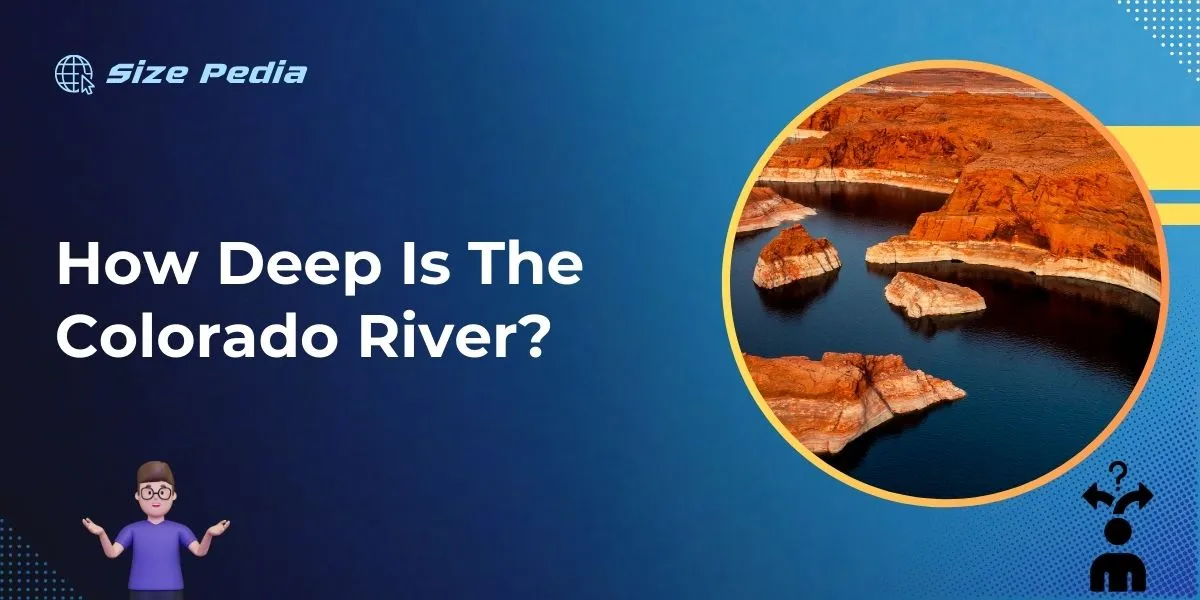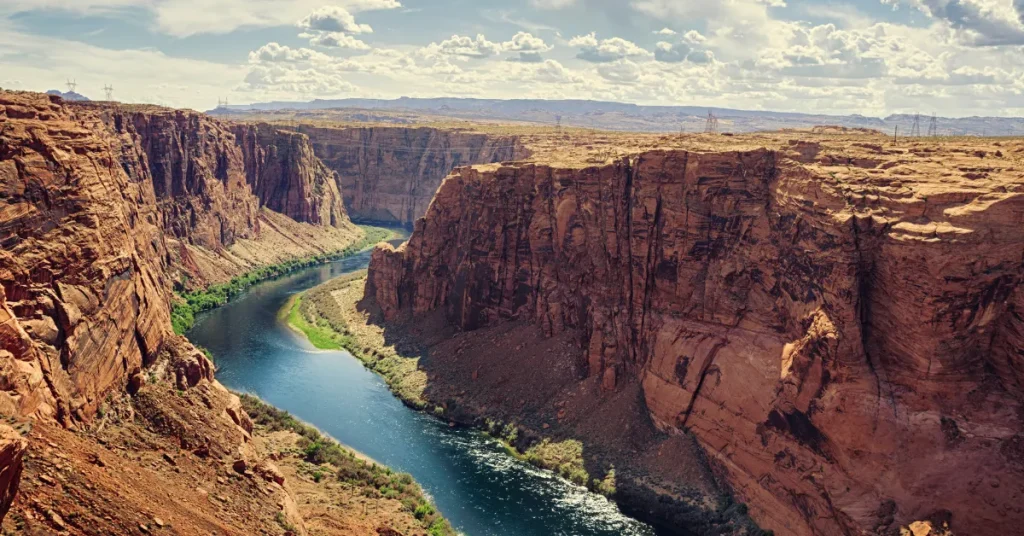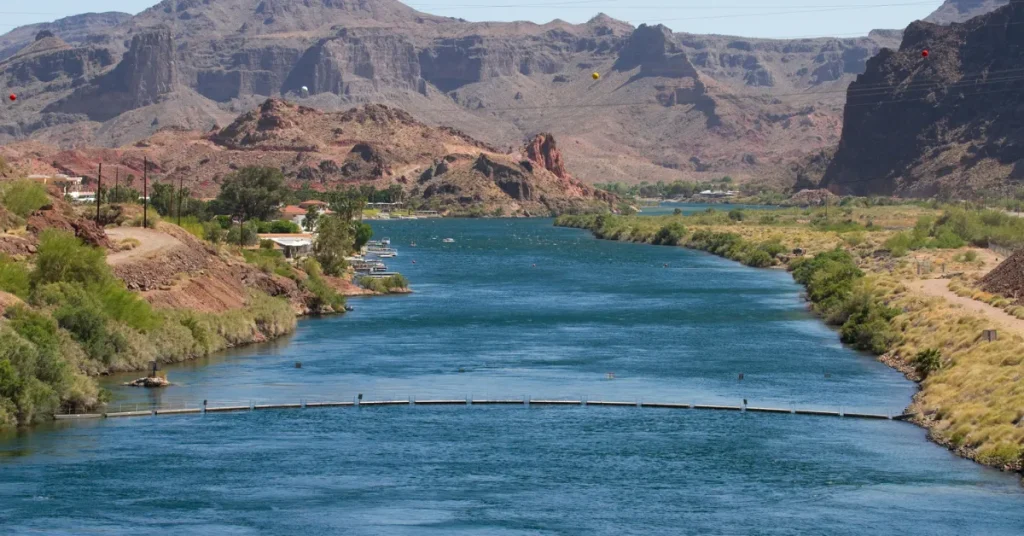The Colorado River depth varies, averaging around 20 feet. In its Grand Canyon stretch, depths can exceed 100 feet.
The Colorado River is a major waterway of the southwestern United States and northwestern Mexico, known as one of North America’s longest and most historically significant rivers.
Its 1,450-mile course carves through landscapes, shaping remarkable ecosystems and supporting diverse communities along its path.
Originating from the Rocky Mountains in Colorado, the river flows into Mexico, where it empties into the Gulf of California. Although the depth of the river fluctuates with terrain and dam locations, it remains a critical resource for irrigation, recreation, and habitat.
Traversing through 11 U. S. National parks, the river’s influence on the region’s geography and culture is profound, making it a point of study and fascination for geologists, historians, and visitors alike.

The Colorado River’s Significance
The Colorado River threads through the rugged landscape, weaving a history of life and livelihood. This majestic river’s depth may vary, but its significance runs deep in the heart of American geography, ecosystems, and the lives it touches.
Geographical Influence
The Colorado River flows through seven U.S. and two Mexican states. Its course has shaped some of the most iconic landscapes, including the Grand Canyon. Cities like Las Vegas and Los Angeles rely heavily on its waters.
- Carves through 1,450 miles of North America
- Provides water to 40 million people
- Generates hydroelectric power
Role In Ecosystems And Biodiversity
The river’s ecosystem is a cradle for biodiversity. It supports numerous species of fish, birds, and plants. The Colorado River delta, once a vast desert estuary, is now a critical habitat for wildlife.
| Species | Type |
| Humpback Chub | Fish |
| Southwestern Willow Flycatcher | Bird |
| Cottonwood | Plant |
Measuring River Depths
The mystery of the Colorado River’s depth attracts many. It changes from shallow ripples to profound depths.
To uncover these mysteries, we must measure accurately. Understanding the river’s depths is vital for safe navigation, environmental studies, and water management.
Techniques For Depth Assessment
Scientists use various methods to measure river depths. These ensure that data is both accurate and reliable for different uses.
- Echo sounding: This technique employs sound waves to determine depth.
- ADCP (Acoustic Doppler Current Profiler): ADCP sends sound pulses into the water, measuring both depth and current velocity.
- SONAR (Sound Navigation and Ranging): Similar to echo sounding, SONAR provides more detailed images of the riverbed.
- GPS and Surveying Equipment: For precise location data, GPS integrates with depth measurements.
Combining these methods gives a comprehensive depth profile of the river.
Challenges In Capturing Accurate Depths
Capturing the Colorado River’s depth comes with unique challenges. The river’s dynamic nature makes accurate measurements tough.
- Variable Water Levels: Seasonal and weather changes cause water levels to rise and fall.
- Flowing Currents: Strong currents can impact instruments, affecting readings.
- Remote Locations: Some river portions are difficult to access, hindering measurement attempts.
- Sediment and Debris: Sediment movement and floating debris can alter depth readings.
Despite these challenges, continuous innovations in technology help in obtaining precise depth measurements.
Varied Depths Along The Course
The Colorado River, a lifeline that carves through the arid American Southwest, teases with its varying depths.
As travelers embark on their journey down this mighty river, they’ll discover a staggering range of depths from the shallow ripples near its source to the profound chasms further downstream. Let’s explore the river’s depth as it winds its way from mountain to sea.
Depth Variation From Source To Mouth
The journey of the Colorado River begins high in the Rocky Mountains, where its shallow streams are a stark contrast to the depth it achieves further along its course.
As the river snakes across different terrains, its depth constantly changes, revealing just how dynamic and alive the river truly is.
- Mountain Streams: Often just a few feet deep
- Canyons and Valleys: Depths increase significantly
- Lower Basin: River widens, with variable depths
Deepest Points Of The Colorado River
Among the most awe-inspiring sights along the Colorado River are its deepest points where the river has expertly carved its way through rock over millions of years. Let’s dive into the depths of the Colorado River’s most profound sections.
| Location | Approximate Depth |
| Grand Canyon | Up to 85 feet |
| Glenwood Canyon | 40 to 60 feet |
| Marble Canyon | Varies greatly |
The grandeur of the Grand Canyon, in particular, boasts the deepest depths, presenting a mesmerizing display of the river’s force and the earth’s resilience. Whether feet dip into gentle shallows or gaze into the cavernous depths, the Colorado River holds secrets at every turn.
Human Impact On Colorado River Depth

The depth of the Colorado River has changed greatly due to human activities. Dams and water removal are two major actions. They affect how deep the river can be. Here we will look at what happens to the river when humans interact with it.
Effects Of Dam Construction
Dams play a big role in altering the Colorado River’s depth. When dams are built, water collects behind them. This creates large reservoirs.
The water stored in these reservoirs can be very deep. Farther downstream, the river may run shallow. This is because the dam controls how much water flows out.
Dams impact water flow and ecosystems. They can also affect recreation and wildlife habitats. Here are key points:
- Reservoirs can be deep and cover a large area.
- Downstream sections may suffer from reduced water levels.
- Changes to habitats and fish populations are common.
- Recreation activities like rafting may be impacted by flow changes.
Consequences Of Water Extraction
Water extraction refers to removing water from the river. People use this water for homes, farms, and businesses. When too much water is taken, the depth of the river decreases. This can harm the river’s health and ecosystems that depend on it.
The effects of water extraction include:
- Lower water levels, making the river shallower.
- Strain on wildlife that needs certain water depths to survive.
- Fewer resources for plants and animals along the riverbanks.
- Reduced water quality, which affects all types of river uses.
To sum up, human impact on the Colorado River’s depth is significant. Dam construction and water extraction are leading causes. They lead to lasting changes in the river’s depth and health.
Natural Events Shaping Depth

The Colorado River’s depth is ever-changing, sculpted by the forces of nature. Over time, natural events continually redefine its depths and boundaries.
In this section, we’ll explore two key natural events that significantly influence the river’s depth: sedimentation, erosion, and flooding.
Sedimentation And Erosion Dynamics
Sedimentation and erosion are constant along the Colorado River. These natural processes are vital in shaping its depth. Sediment builds up and is washed away, altering the riverbed.
- Sediment builds: When the water slows down, dirt and sand settle.
- Erosion happens: Fast water picks up and moves these sediments.
Sediment levels vary, impacting the river’s depth at different points and times.
Floods’ Role In Altering Depths
Floods play a crucial role in changing the Colorado River’s depth. Heavy rains and snowmelt can lead to sudden floods. These events can deeply reshape the riverbed.
| Event | Impact |
| Floods | Increase depth and width |
| Snowmelt | Raises water level, impacting flow and depth |
Floods can create new channels or deepen existing ones in moments.
Exploring Beneath The Surface
The Colorado River, a lifeline of the Southwestern United States, holds secrets beneath its waves. Its depth, varying greatly along its course, creates an ever-changing world. A world that invites us to uncover the hidden life it sustains.
Let’s dive deeper into the waters of the Colorado River and discover the marvels that lie beneath.
Hidden Ecosystems In River Depths
The Colorado River’s depths are teeming with life. As sunlight penetrates the surface, it unveils a variety of habitats. Each twist and turn of the riverbed fosters a unique ecosystem.
- Riparian Zones: Lush areas that host a diversity of plants and animals.
- Deep Pools: Spots where water runs deep, providing a haven for different fish species.
- Swift Currents: Home to organisms that thrive in the river’s fastest-flowing parts.
The variability in the river’s depth results in niches that support a wide range of species. This diversity ensures each organism plays a crucial part in the river’s overall health.
The Quest For Underwater Mysteries
The Colorado River is a treasure trove of wonders waiting to be explored. Scientists and adventurers alike embark on a journey to decipher its underwater mysteries. Each expedition brings them closer to understanding the river’s hidden depths.
| Year | Achievement |
| 1923 | First detailed mapping of the river’s bed |
| 1996 | Discovery of previously unknown aquatic species |
| 2010 | Advanced sonar exploration revealing new depths |
This relentless pursuit enriches our knowledge about the Colorado River. Findings contribute to conservation and offer insight into the complex underwater ecosystems.
FAQs About How Deep Is The Colorado River
What Is The Average Depth Of The Colorado River?
The average depth of the Colorado River is approximately 20 feet. However, depths can vary significantly depending on location, from shallow rapids to deep canyons.
Does The Colorado River’s Depth Fluctuate Seasonally?
Yes, the Colorado River experiences seasonal depth changes. Snowmelt typically increases depth in the spring and summer, while lower levels often occur in fall and winter.
Where Is The Deepest Part Of The Colorado River?
The Colorado River’s deepest part is within the Grand Canyon, where it can plunge to over 85 feet in depth at certain points, specifically in the gorge sections.
How Does River Management Affect The Colorado River Depth?
River management, including dam operations, significantly affects the Colorado River’s depth. Regulated water releases from dams can raise or lower water levels, impacting depth throughout the year.
Conclusion
The depth of the Colorado River varies, presenting both grandeur and mystery. From shallow rapids to deep canyons, it embodies natural diversity. Exploring its waters offers insights into unique ecosystems.
For those seeking adventure or tranquility, the river’s depths are compelling, inviting us to delve deeper and respect this mighty waterway’s role in our world.
Resources:
1. https://www.usbr.gov/ColoradoRiverBasin/
